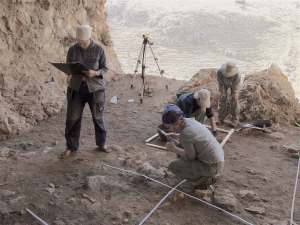by Aaron Jonas Stutz

My collaborators Liv Nilsson Stutz, Chantel White, and I have recently surpassed our crowdfunding goal on experiment.com for the project “How Did Paleolithic Hunter-Gatherers Use Plant Resources in Eurasia?”. We are so grateful to our project backers, who will be receiving exclusive updates and reports while we prepare, carry out, and wind down our fieldwork at the Mughr el-Hamamah site, Jordan, this summer. With 6 days to go in our crowdfunding campaign, we do ask that you consider becoming a backer at any level (thanks to those of you who have given us $1 or $2 dollars!). We want to increase the size of the crowd and encourage broader funding of projects on experiment.com and similar crowdfunding platforms. Crowdfunding is not a replacement for traditional public and private grant sources, but it is a great source of matching funds. Crowdfunding is interactive and encourages more transparent, open-access science that can be shared in real-time with interested non-specialists.
We just posted the following thank you Lab Note on our crowdfunding site, highlighting the benefits of investment in open science, both in general and for our project in particular:
Thanks to all of our generous backers, from family and friends to complete strangers, for helping us get to our funding goal. We’ve now surpassed $7300, with 6 days to go in our crowdfunding campaign. Your contributions will help in all of the following ways:
- Hybrid funding sources: You are helping the dollars granted by the Wenner-Gren Foundation for Anthropological Research to go farther, in helping us carry out our inquiry into our shared hunter-gatherer past.
- Support the culture heritage management work of the Department of Antiquities of Jordan.
- Create educational and training opportunities for our undergraduate volunteers and graduate assistants.
- Strengthen the connections among the wider network of collaborations that go beyond this particular funding campaign — as we raised our funds, Prof. Rosa Albert of the Catalan Institution for Research and Advanced Studies obtained funding to visit our excavation in late July to sample the Mughr el-Hamamah archaeological layers for plant phytoliths (microscopic silica crystals that plant cells generate, leaving us with another kind of forensic trace of plant remains). In addition, Dr. Dustin White has received funding from the Leverhulme Trust to visit us in the field, too. He will sample additional bits of sediment to look for volcanic ash grains (tephra) that may have blown into the cave 45-39,000 years ago. His work will help us to connect our reconstruction of the local environment around Mughr el-Hamamah with the wider environmental context of the Mediterranean Basin at this juncture in our shared prehistory.
- Support the field research infrastructure maintained by the Yarmouk University Faculty of Anthropology and Archaeology. Their research station in the Jordan Valley will provide us with the field lab facilities to make our work proceed as efficiently as possible!
- Spread the word about experiment.com, crowdfunded science, and the benefits of such funding for encouraging transparent, interactive research processes/sharing of results.
We do have 6 days remaining in our crowdfunding campaign. We’d love for the crowd of backers to grow. Please consider sharing and encouraging interested friends and family to back our project–or any other seeking funding on experiment.com. The $1 and $2 contributions help and get all of the backers-only updates we’ll be sharing with you as the project proceeds through early August. After that, your investments will have yielded a record of the research process–from planned milestones and reports, to updates about unexpected, exciting discoveries–that researchers, students, and the wider public will be able to access openly.
Thank you all for your support.
very best,
Aaron, Chantel, and Liv
Again, you can go to http://experiment.com/paleoplants and back our project, until the end of the day on Friday April 14. By surpassing our funding goal, we can expedite laboratory analyses of some of the artifacts and sediments already sampled and curated from our first excavations in 2010. You would also help us to support directly an additional graduate field assistant, making our work more effective during our limited field season in late June and July of this year. Remember that archaeological research dollars go a long way in documenting, investigating, and conserving cultural and environmental heritage that we can all access, learn from, and discuss, bringing us all closer together.